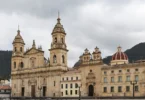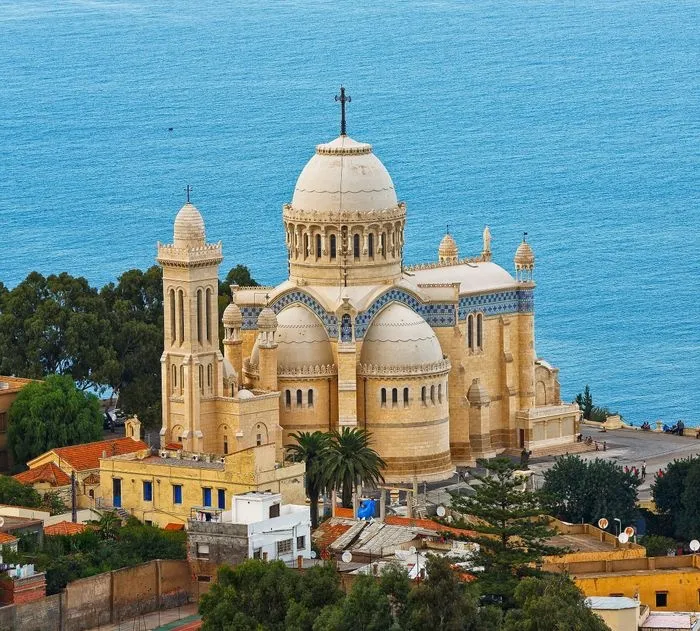
Introduction
Basilique Notre Dame d’Afrique (English: “Basilica of Our Lady of Africa”) is a Catholic basilica in Algiers, Algeria. It is the origin of the modern Catholic devotion to Our Lady of Africa. Notre Dame d’Afrique is on the north side of Algiers, on a 124 m (407 ft) cliff overlooking the Bay of Algiers. It formerly could be reached from the city centre by a cable car. It can be considered to be the counter-piece to the church of Notre-Dame de la Garde on the other side of the Mediterranean. From the basilica, the view is magnificent onto the sea but also onto the Saint-Eugène cemetery which three distinct sections – Islamic, Christian and Jewish – are all especially well preserved.
The Notre-Dame d’Afrique basilica was built thanks to the faith and tenacity of two Christians: Marguerite Berger and Agarithe Cinquin. They were able to convince the bishop of Algiers at the time, Mgr Pavy (1846-1866) to undertake the construction of the building (1846-1866) which was finally inaugurated by Cardinal Lavigerie in 1872.
Since then, this church has been a place of prayer and pilgrimage for generations of Christians who came there to pray for themselves, for their children, for sailors at sea, for missionaries who went far away to proclaim the Gospel, for combatants, prisoners or the sick.
But what, from the beginning, was to give Notre-Dame d’Afrique its particular meaning was the influx of the Algerian Muslim population to this sanctuary. Very early on, in fact, she was to join the humble pilgrimage to Notre-Dame du Ravin, before coming to visit Lalla Meriem in the basilica itself.
A sentence can be read on the apse wall, written in French, Arabic and Berber: “Our Lady of Africa, pray for us and for the Muslims.” And this is fact: for more than 150 years, Christians and Muslims come for protection to the Lady of Africa. The inscription in the apse is still present to this day to give this dimension of prayer in the basilica
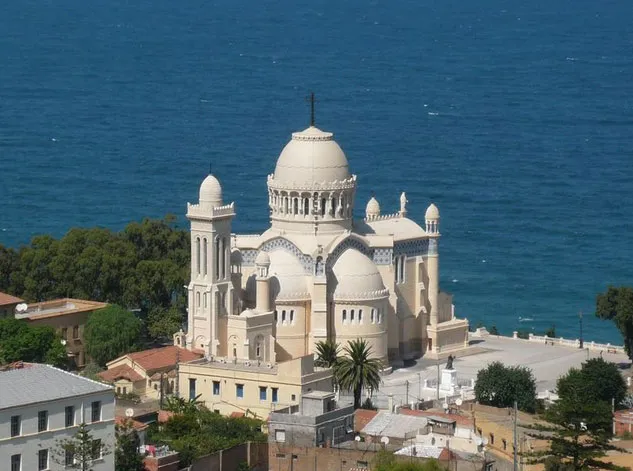
Two young ladies, originally from Lyon, working in the maintenance of the seminary, are at the origin of the pilgrimages to Notre Dame d’Afrique: Marguerite Berger, called Mademoiselle Agarithe and Anna Cinqin.The two girls placed a statue of Virgin Mary in the trunk of an olive tree as a tribute to their hometown sanctuary. The Saint-Joseph Chapel is the first incarnation of the basilica, for which construction started in 1858 and ended in 1872, when it was blessed by Archbishop Lavigerie.
The basilica was founded by Charles Lavigerie and was eventually inaugurated in 1872 after 14 years of construction. Its architect, Jean Eugène Fromageau, who had been chosen as the chief architect for ecclesiastical buildings in French Algeria in 1859, employed a Neo-Byzantine style. Its floor plan is unique and atypical as the choir is located on the southeast instead of the normal east side of the building.
Two young ladies, originally from Lyon, working in the maintenance of the seminary, are at the origin of the pilgrimages to Notre Dame d’Afrique: Marguerite Berger, called Mademoiselle Agarithe and Anna Cinqin.
The construction of the basilica lasted 14 years. The structural work was carried out between 1858 and 1866 under the episcopate of Mgr Pavy. Cardinal Lavigerie completed the work in 1872.
Christians experienced rapid expansion in North Africa from the first centuries of the Christian era. Their memory has reached us and can be found in this basilica. There were among them great thinkers, the most famous of whom was Saint Augustine, bishop of Hippo (Annaba). Many vestiges remain from this period: mosaics, ruins of churches, inscriptions.
Under Muslim pressure, little by little, the Christians disappeared. During the Ottoman period, from the 17th to the 19th century, Christians, especially Europeans, were present on the coast of North Africa, as consuls, traders, slaves, prisoners of war, or religious.
During colonization in 1830, the Christian presence resumed and a bishopric was erected in Algiers (former Icosium).The first bishop appointed was Antoine-Adolphe Dupuch. He worked to establish churches and parishes. It was he who acquired, thanks to the generosity of young girls from Lyon, a bronze statue, newly created, under the title of the “Faithful Virgin”.
In 1846, Mgr Louis-Antoine-Augustin Pavy succeeded him. He came from Lyon. Two young women accompanied him: Agarithe Berger and Anne Cinquin to take care of the maintenance of the seminary established in the valley of the Consuls, where the bishop had his residence.
The places are very rugged, backed by the Bouzareah Mountain and hollowed out by deep ravines, with vegetation of pines, old olive trees and thorn trees. In their piety, these two young ladies installed a statuette of Mary in the hollow of an old tree, at the bottom of the nearby ravine. Very quickly the Christians of St Eugène (Bologhine) came there on pilgrimage. This place was called, quite naturally, Notre Dame du Ravin.
But that was not enough for these two women, who insisted that the bishop build a real church. Bishop Pavy hesitated due to lack of money. He made his decision on December 8, 1854 and very quickly a committee was set up, an architect found, well-located land acquired. A name stood out: Notre Dame d’Afrique, because we were aware that Algiers opened onto the immense continent.
The architect Fromageau began by building in 1857 a small temporary chapel – today called “St Joseph chapel” – nestled behind the large basilica. A statue of Mary had to be placed there. Mgr Pavy installed “the faithful Virgin” that his predecessor had received and who was with the Trappist fathers in Staouéli. The foundations of the basilica were dug from February 2, 1858 and little by little the construction grew. The structural work was finished when Mgr Pavy died in 1866. One of the many tasks of his successors Mgr Lavigerie consisted of completing the work begun.
In 1872 the archbishop was able to inaugurate the basilica, and on July 2, he consecrated it. The following year, the statue known as the “Faithful Virgin” was enthroned there, now called: Our Lady of Africa. He was able to obtain a double favor from Pope Pius IX: that this sanctuary has the title of “Basilica” (minor), and that the statue of the Virgin is crowned.
From 1868 to 1873 the spiritual animation of the “provisional chapel” and the basilica was entrusted to the Premonstratensian monks of Saint-Michel de Frigolet in Montagnette in Provence.
When the Premonstratensians left, the White Fathers took over before giving way to the diocesan clergy. In 1930 the White Fathers returned and still ensure the activities of the basilica.
Over the years, during the Marian feasts and liturgical feasts of the Roman Catholic Church, and even every day, visitors and pilgrims have climbed the hill with the means of each era: Christians and Muslims rubbed shoulders there. From the beginning, it was written on the wall in the choir of the basilica: “Our Lady of Africa, pray for us and for the Muslims”. Little by little these wooded places were cleared and an increasingly large population settled.
Very close to the basilica, an apostolic Carmel was founded in 1892 which had to be abandoned in 1911. A boys’ college was established there from 1920. After the Great War, in 1920, Archbishop Leynaud established a college there for boys: Notre-Dame d’Afrique Institution. In 1975, it became the Lycée Ibn Khaldoun.
In 1920, the Franciscan Sisters Missionaries of Mary were called to take care of a girls’ orphanage, and above all, to be worshipers of the Blessed Sacrament at the basilica every afternoon. To house the chaplains, the archdiocese purchased the Charmant Séjour hotel from Mr Bompard, which had been built around 1900. The priests’ accommodation is still there.
Mgr Leynaud was keen to modernize and decorate the basilica. Thus he provided for the first electrification in 1921. In 1930 he had the gallery built to accommodate the large organ donated by Mr Weddell. In 1937 a fresco was painted in the choir apse by the Belgian artist Emile Deckers. Degraded by rain infiltration, it had to be replaced in 1993.
The first cross on the dome dates from 1866. The basilica is a very solid construction, resistant to earthquakes, but which is subject to the onslaught of rain and winds which gradually eat away certain stones, and the joints with sand and mortar mortar lime used in the 19th century.
The restoration project took place between 2007 and 2010, restoring all its beauty to this Algiers monument. A superb illustrated album has been published to preserve the memory of this historical, cultural and technical moment.
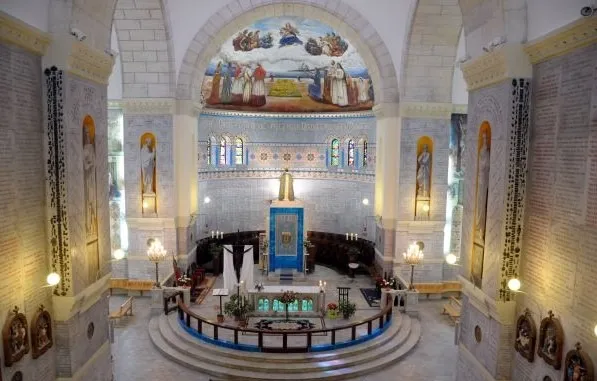
The pilasters serve as external buttresses for the building, supporting the drum hangers and dome. Each pilaster is equipped with a groove, intentionally aligned with the cardinal points by the architect. Positioned at the center of the cube, the NORTH pilaster is on the right, the EAST pilaster is on the left, the WEST pilaster is in front to the right, and the SOUTH pilaster is in front to the left. The basilica is precisely oriented along the North-East (toward the sea) and South-West (toward the mountain) axis.
Examining the apses, you’ll find a consistent design—a standing half-cylinder, 10 meters tall, supporting a quarter-sphere vault with a 5-meter radius. The central apse, or choir, houses the bronze statue of Mary on a pedestal, adorned in a Tlemcen-style dress and mantle. Wooden stalls, a large oval space, a wooden balustrade, and three marble steps together constitute the choir, a central space for the celebration of eucharists, Christian ceremonies, and prayers.
Facing the nave, with the balustrade ahead, the apse of St Augustine, featuring a statue of the saint above the altar, is on the left. On the right, you’ll find the apse of St Monica, mother of Augustine, with a corresponding statue. Throughout the surroundings, frescoes, stained glass windows, and various marbles adorned with inscriptions celebrate Our Lady and convey the essence of Africa.
The central fresco,completely renewed in 1993, and which only partially repeats that of 1937 (by the Belgian painter Dékers), is the work of the Algerian Mohammed Bouti and the Mexican Salvador Lira.
We see in heaven: Mary and the child Jesus, on their left St. Cyprian, on their right St. Augustine, two great North African Christian thinkers, as well as Christian figures from the first centuries in North Africa.
And on earth: on the left, Cardinal Lavigerie, Charles de Foucauld, Cardinal Duval; on the right presenting the model, Miss Agarite, who is at the origin of the pilgrimage. Other characters symbolize all the inhabitants of Africa in their diversity and also the White Fathers and the White Sisters. We can see, in the middle, the Christian mosaic discovered in Matarès (Tipaza) in 1968.
The basilica has 2 beautiful doors recently redone. They are made of Oregon pine. Above,the statue of Our Lady of Africa, 3 meters high, welcoming visitors. The dome which rises to 48 meters is topped by a 4 ton cross. This beautifully proportioned dome is carved with Marian symbols. The triple stone crown of the dome symbolizes Mary Virgin, Mother and Queen.
The basilica contains 46 stained glass windows installed in the 19th century. They were blown out during a bombing of the area in April 1943 and have been restored twice since the end of World War II. The basilica was also damaged by the 2003 Boumerdes earthquake. A renovation project was initiated in 2003 by Henri Teissier, the archbishop of Algiers, but the actual development work did not begin until the spring of 2007. The entire project took 3 years to complete.
The church is a magnificent structure in sand coloured stone with several domes of differing sizes at different elevations. There is a detailing in blue along the upper edge of the structure from outside which hints at the Moorish influence. It has been described as “appearing from a certain angle like a giant camel on its haunches, contemplating the Aleppo pine- and eucalyptus-covered hills”
There is a statue of the Virgin Mary in black stone. The interiors are quite stark and the altar is very simple. On the wall behind it is a plain cross. A solid silver statue of the archangel Michel that belongs to the confraternity of Neapolitan fishermen also has a home in the church.
Organ in Basilica of Our Lady of Africa
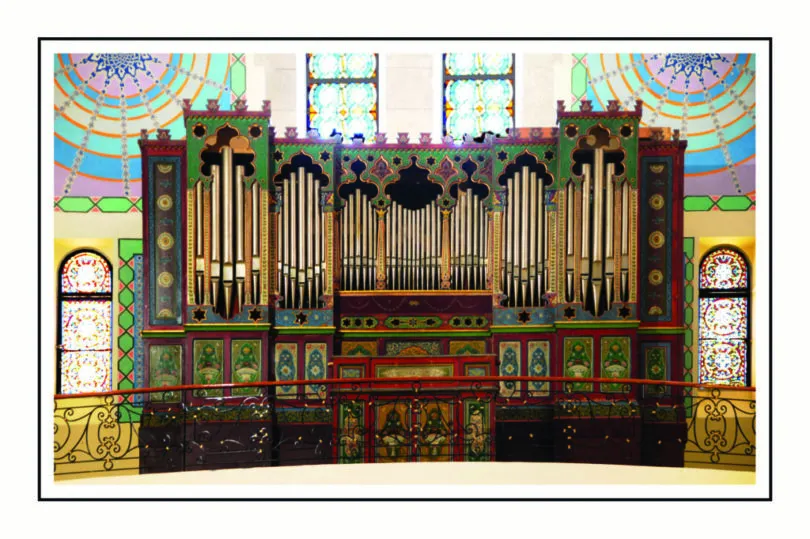
The organ of Notre Dame d’Afrique was originally a living room organ belonging to Mr Weddell living in Algiers, Villa Georges, at 47 Boulevard du Télemly. Advised by Camille Saint-Saëns, he ordered an instrument from the organ builder Charles Mutin, a student of Aristide Cavaillé-Coll.
The fire wood case is magnificently painted, in the Algerian style – this organ has 3 keyboards and a pedal board and it has 26 stops and has 1388 pipes. Made in 1911, it was offered to the basilica in 1930 by Mrs.Weddell after the death of her husband. It was completely restored to its original condition in 2002. Concerts are given there.
The instrument has 26 stops. Among the possible games, Weddell chose those that could imitate the sound of Middle Eastern musical instruments. This organ is of certain musical and instrumental interest. It is part of the history of music in Algeria. It is a very valuable instrument. There is an authentic historical monument there.
The bells
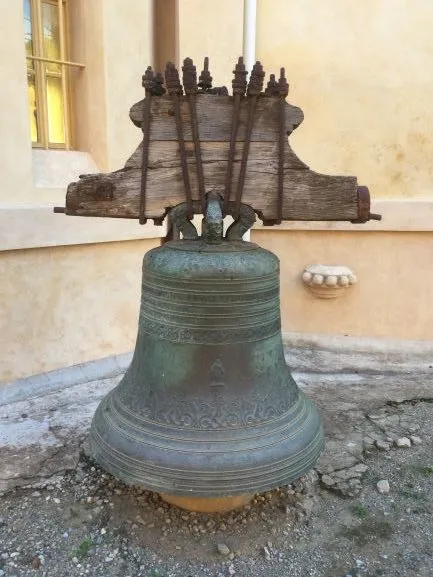
The bells of the Basilica are there, with their name, testifying in their own way to the history of Our Lady of Africa. In the campanile, there were six large bells with dates from 1869 and 1876.
Another series of bells, dated 1954, forming a carillon, with indication of the musical note they ring (Ave Maria de Lourdes), is located on a line perpendicular to the ladder sealed in the wall leading to it.
The two heaviest were removed in 2010, to relieve the campanile structure of 2 tonnes, and were placed next to St. Joseph Chapel. Today the bells no longer ring.
A Sign of Religious Tolerance
The Notre Dame d’Afrique is seen by many as a sign of religious tolerance in a country that is predominantly Muslim. The inscription on the curved wall behind the altar has the words, “Notre Dame d’Afrique priez pour nous et pour les Musulmans“, which translates to “Our Lady of Africa, pray for us and for the Muslims“.
Saint-Joseph chapel
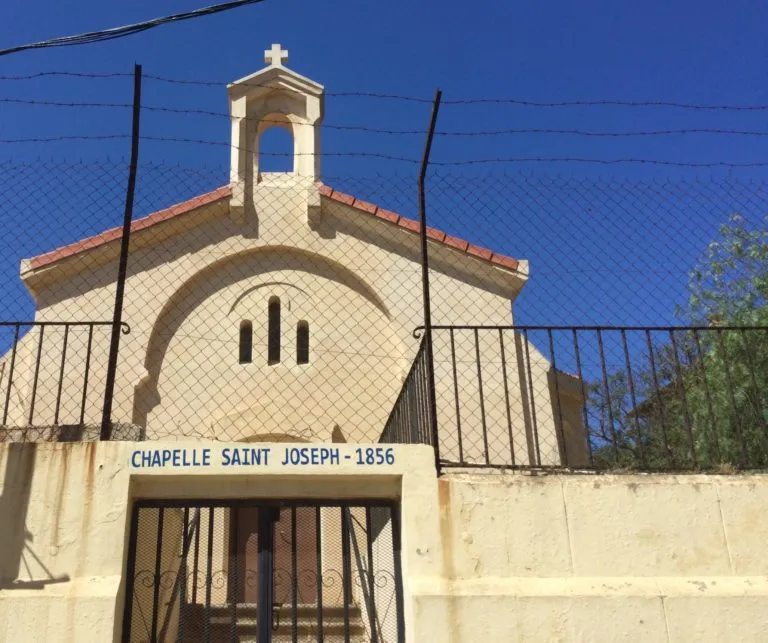
The St Joseph chapel of Notre-Dame d’Afrique was initially a temporary place of worship for a Marian sanctuary wanted in some way by Agarithe BERGER and Anna CINQUIN, two young girls from Lyon who worked at the St Eugène minor seminary. It should be noted immediately that: “on July 2, 1857, the construction of the chapel began, which will be open for worship on the following September 20, on the feast of Our Lady of the Seven Sorrows. »
It is clear that this chapel is worth much more than a temporary chapel for believers then and today. It is in fact, the humble beginning of an unprecedented Marian cult throughout Algeria and beyond its borders where hundreds of believers will brave this difficult to access place. In this same vein, she brought hope for the creation of the Notre-Dame d’Afrique basilica that we have today. It was also the place of fervent prayers and devotion to St Joseph, especially Agarithe, devoted to the cause of this larger Marian sanctuary as well as to Notre-Dame de Fourvière.
Agarithe accompanied her prayers with the sale of objects of piety, in order to help raise the sum required for the construction of the Basilica. She will say on the occasion of the laying of the first stone: “so much for the first stone. St Joseph will have to provide the means to finish him off. Indeed, Agarithe had a permanent devotion to St Joseph for the creation of the basilica by installing a painting of this saint in the shop with a candle always lit next to it.
This is an expression of faith from a Christian who testifies to the solicitude of St. Joseph, of a father who anticipated with all his strength the needs of the holy family of Nazareth. The man with “creative courage” in the words of Pope Francis in Patris Corde on the occasion of the 150th anniversary of the proclamation of St Joseph as patron of the Universal Church (proclamation of the year of St Joseph) where he says this
“God intervenes through events and people. Joseph is the man through whom God takes care of the beginnings of redemptive history. He is the true “miracle” by which God saves the Child and his mother. Heaven intervenes by trusting in the creative courage of this man who, arriving in Bethlehem and not finding accommodation where Mary can give birth, sets up a stable and arranges it so that it becomes, as much as possible, a welcoming place for the Son of God who comes into the world (cf. Lk 2:6-7).
This temporary chapel will be dedicated to St Joseph on the occasion of the transfer of the statue of the Virgin to the Basilica. And it is: “on May 4, 1873, the bronze Virgin, carried by 12 sailors dressed in white, will be transferred from the temporary chapel and enthroned behind the main altar in the presence of Mgr Lavigerie…” This decision was taken by Cardinal Lavigerie without knowing that Agarithe had formulated this wish in a note that she accidentally left in the bulletin of Sainte Monique intended for one of her friends in Lyon, to see the temporary chapel of Notre-Dame dedicated to St Joseph in these terms “I am convinced that the small chapel of Notre-Dame d’Afrique will one day be dedicated to Good St Joseph; Before the thing happens, I feel the need to write it here.
We then note that this chapel carries holy history of events and people in the Church of Algeria. As a reminder, it is in this chapel that the first Missionaries of Africa (White Fathers), made their missionary commitments, namely: the taking of the habit on February 8, 1869 of four novices (Félix Charmetant, Charles Finateu, Léon Bouland , Francisque Deguerry). Others will take their Missionary Oath and be ordained priests in this chapel.
It is here that on April 27, 1950, Mgr Durrieu, Superior General of the White Fathers at the time, extracted a stone intended to be placed in the foundation of the general house in Rome. Miss Agarithe BERGER found her final resting place in the chapel when she was called back to the Heavenly Father in 1875.
This chapel continues its mission in the lives of Christians on the hill and all those who come to recharge their batteries spiritually. It is the Place of monthly adoration on the first Friday of the month that our father bishop Mgr Paul DESFARGES wanted. It is a quiet place for personal meditation, recollections, and daily masses especially when it is too hot or cold in the basilica. We also welcome spectators, walkers, catechumens and people who come to seek an attentive ear in the discretion of this chapel.
Muslim-Christian Marian Day of Algiers
The Muslim-Christian Marian Day (JMIC) of Algiers is an initiative of the Notre-Dame d’Afrique basilica to promote dialogue, peace and fraternity between Christians and Muslims. This day is based on the conviction that Christians and Muslims are brothers, and that together they can promote peace and understanding between men and women of all cultures, languages, peoples and nations. Any person of good will who loves peace and living together can participate.
Annual Feast Day
Annual Feast Day –30th April.
The annual feast day of Church of Notre Dame of Africa is celebrated on 30th April each year.
Mass Timing
Weekdays
- Monday 06:00 pm
- Tuesday 06:00 pm
- Wednesday 06:00 pm
- Thursday 06:00 pm
- Friday 10:30 am
Weekend days
- Saturday 06:00 pm (1st Saturday in English)
- Sunday 06:00 pm
Contact Info
3 avenues Ali Ourak
Bologhine
16070 Algiers
Phone No.
Phone: +213 23 15 40 19
Accommodations
How to reach the Sanctuary
Airways
The nearest airport to the church of Notre dame of Africa is Algiers International Airport Houari Boumediene which is 24.1kilometers away from the church.
Railways
The closest railway station to the church of Notre dame of Africa is Algiers Central Railway Station, also known as Agha station which is 8.2 kilometres away from the church

